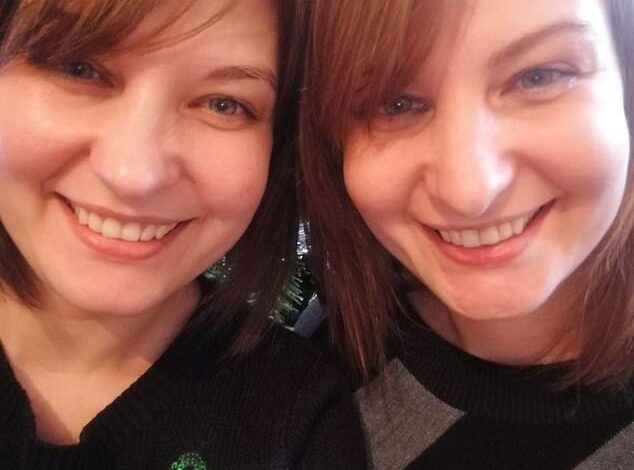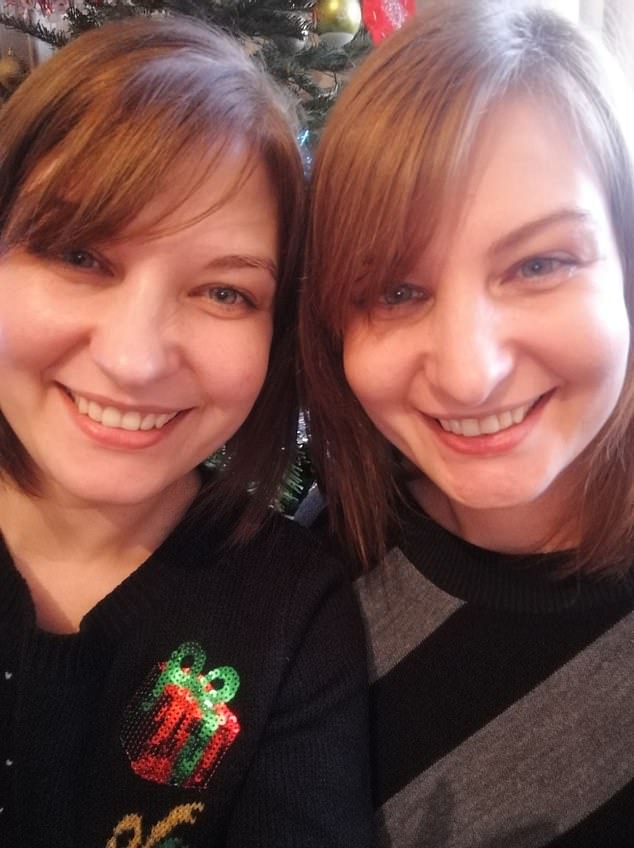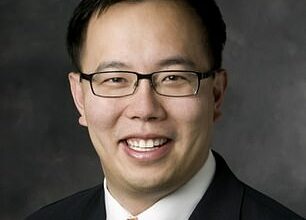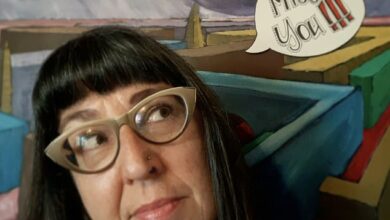My identical twin went to A&E with a headache. The next day I had to watch her die after she was covered with a coat and ignored like a homeless person







Very little could separate identical twins Inga and Inese. Even though, as adults, they ended up living in different countries, they messaged or chatted incessantly, never out of touch.
So when Inese Briede, a teacher, could not get hold of her twin on a Saturday morning in January, she was concerned, especially because Inga had been complaining of a severe headache the day before.
Indeed, Inese had been the one to persuade Inga (‘who never liked to make a fuss’) to go to A&E, just to be checked out. Odd, then, that Inga hadn’t updated her sister overnight.
‘It was early in the morning. I tried phoning, WhatsApping, normal voice calls,’ Inese recalls. ‘She still didn’t pick up. I tried one last time – a videocall, and this time it was answered. I thought, ‘Oh she’s picked up, but she must have been sleeping. She will give me a hard time because I have woken her’.’
How she wishes that had been the case. Instead, the face of a nurse in uniform came on the screen, and it dawned on Inese that the bright striplights she could see on the ceiling were ‘not from Inga’s apartment’.

Inese Briede and Inga Rublite in their last picture together, aged 34, at Christmas

Inese had to suffer the trauma of receiving a video call from a nurse treating her sister
‘I remember thinking, ‘That is the hospital. Why is Inga still in the hospital?’ Then the nurse said, ‘Who is calling?’ and I told her I was Inga’s identical twin.
‘The nurse said, ‘You need to come to the hospital right away’. I could see legs behind her. I think they were my sister’s legs.’
So began her worst nightmare. A day later, Inese was at her sister’s bedside as her life-support machine was turned off.
It is hard to comprehend the horror of watching your identical twin die.
‘We had shared everything. She was a part of me,’ says Inese, 39. ‘If she went blonde, I went blonde. If she dyed her hair black, I went black. We even had identical tattoos.
‘To see her lying in that hospital bed, with all those tubes, it was like looking at myself. I said, ‘This cannot be the end.’ How has this happened? She only went to hospital with a headache. And she was in the best place. To me hospital means ‘safe’.’
One family’s unthinkable tragedy, of course, but the death of Inga Rublite should shame us all. For Inga was not ‘safe’. Despite presenting at Queen’s Medical Centre in Nottingham – one of the country’s leading teaching hospitals – with a searing headache, blurred vision and neck pain (all textbook symptoms that should have alerted staff to the possibility of a bleed in the brain) she was assessed only by junior staff and at no point saw a doctor, who were all unavailable due to an ambulance backlog. Nor was a vital brain scan ever requested. Inga waited, and waited, to be seen.
An inquest into her death last month determined that she spent eight hours in a chaotic waiting area, which was operating at almost double patient capacity (maximum capacity was 38 but at one point there were over 70 patients waiting for attention).

The girls aged six. While they were part of a large family, the sisters enjoyed a special bond

Born in the city of Jelgava only two minutes apart (Inga arrived first) the twins’ lives were often interchangeable. Here they are as young women, aged 21
At some point – and it is a source of great distress that no-one can pinpoint exactly when, because no CCTV footage was kept – Inga ‘slumped’ to the floor.
She was found, covered in a coat, at 7am, too late to be saved. Unable to respond when her name was called, staff assumed she had given up waiting, and simply left.
Coroner Dr Elizabeth Didcock concluded that while she died from natural causes, there were ‘two missed opportunities’ to diagnose Inga. But one of the most shocking facts to emerge from the inquest was that it was not unusual for homeless people to sleep on the floors and seats of the waiting area.
Was the mother of two – whose children, aged 12 and 11, were tucked up in bed at home – mistaken for a vagrant? A matron at QMC told the inquest: ‘Someone sleeping under a coat in our waiting room is not unheard of; a lot of homeless people come and sit in our department, and it is busy and noisy.’
Inese still can’t quite comprehend this: ‘Why don’t security guards move them on and say ‘you cannot sleep here. This is for sick people’?’
This is Inese’s first major interview about her sister’s death. Her grief is still raw, but so is her disbelief that such a thing can happen.
‘How can it, in your NHS?’ she asks, to which there is no answer. She would never have said, before, that the healthcare system in Latvia – where the twins grew up, and where Inese lives – is superior to the British one, but now she wonders.
The family are now preparing to take legal action against the hospital trust, but she is giving this interview ‘because what happened to my sister should never be allowed to happen again’.
How heartbreaking the family photo album now seems. Born in the city of Jelgava only two minutes apart (Inga arrived first) the twins’ lives were often interchangeable.
‘I once sat a maths exam twice because they would not accept that I was not Inga,’ smiles Inese. ‘And once I went on a date in her place because she said she did not like the boy!’
Theirs was a big, boisterous family (they were the youngest of seven siblings) and when they were 18, the sisters moved to the UK, seeing opportunity.
‘We didn’t speak much English at the time, but we soon became fluent,’ Inese remembers, recalling a happy time ‘travelling all around the UK’.
Inga fell in love with Britain, but by the time they were 24, Inese was feeling homesick, and returned to Latvia. Inga opted to stay.
‘It was the first time we went in different directions,’ Inese, who has daughters aged 15 and 12, recalls. ‘But even when I went home, we talked all the time. We had coffee every morning on a video call. She would message me when she saw something funny. She had the best laugh.’
Ironically, it had been Inese who had insisted her sister seek medical help.
On Friday, January 19, they had been in the middle of one their chats when Inga, who was on a lunchbreak at the dispatch warehouse where she worked, suddenly put her hand to her head and winced.
‘She said it felt weird, not a normal headache, but as if something was being squished,’ recalls Inese. ‘I said maybe she should go home, but she said she would take a paracetamol. She said ‘it’s only a headache’.’
She knows now that Inga left work around 3pm and went home, to bed.
‘I woke her up around 9pm when I called to see how she was. She wanted to chat but she said she couldn’t sit comfortably. The pain was worse. She was trying to lie down, but I could see it wasn’t right. I said, ‘Maybe you need to go to the hospital or call an ambulance.”
Around 8.50pm, Inga called 111 – keeping her sister in the loop.
‘First she said someone (from the NHS helpline) was going to call her back, then I asked her to take her blood pressure, and she did – it was high.
‘She called them back, but they told her they were very busy and she should go to the hospital herself. Obviously it was not safe for her to drive, so she asked her neighbour could she take her.’
Inga was a single mother, having split from her sons’ father, and the neighbour also had to leave a child who was under 16.

Inga pictured shortly before her death from a bleed on the brain. She was 39

Queen’s Medical Centre where Inga died in January
‘I still feel that an ambulance should have come at this stage because all three of those children were left on their own,’ Inese says.
Inga was admitted to hospital at 22.39, processed and assessed, but her condition was clearly not deemed life-threatening.
‘But when they were still in the waiting room after midnight, her neighbour said she had to go home to her son, and to check on Inga’s boys.’
Inga was now on her own. ‘And we know from her phone that she was sitting there Googling ‘thunderclap headaches’ which is what the phone operator had told her it could be,’ says Inese. ‘She would have read that this can mean a bleed on the brain. I cannot imagine what she went through sitting there, the pressure building and building in her head.’
Just after midnight, her phone records show that Inga called her youngest son, presumably to check up on him. ‘He didn’t answer because he was already asleep,’ says Inese. ‘The older boy messaged her too saying, ‘I am going to sleep now. Love you’.
‘She did not reply, which was not Inga. She would always have answered. She would have said ‘love you too’ if she had been able.
‘Her boys were her life. She was so proud of them, and so protective. When we knew what had happened, my first thought was, ‘My God. How can we tell those boys’.’
The inquest clarified that around 2am there was a conversation with a nurse, when Inga complained that her symptoms had worsened. At this stage, her case should have been escalated to a more senior medic. It was not.
Inga’s name was called three times between 4.30am and 6.50am. When she did not reply, no-one looked for her, or queried her absence, the inquest heard.
She was only discovered, on the floor, unconscious, at 7am – just as her Inese was starting the process of trying to reach her on her phone.
The fact that she was covered by her coat? ‘I still don’t understand the coat, because it wasn’t cold. All I can think is that Inga pulled the coat over her face to shield her eyes from the bright lights. She said she couldn’t bear the light.’
Inga had been transferred to the ICU unit by the time Inese managed to get a flight to the UK from Latvia. She already knew she was coming to say a final goodbye. ‘The consultant told me on a video call that they could not operate.’
It is pitiful to hear her praise the staff who looked after Inga at the end. ‘At this point, she had good care. They were kind. They helped us do prints of her fingertips.’ She hopes her nephews, who now live with their father, can one day use them for a memento.
Inese tells me that she took the boys out to McDonalds when she was back in the UK for last week’s inquest. ‘I don’t know if it helps them to see me, or makes it more difficult for them, because I look exactly the same as their mother.’
Inga’s death has left an unfillable void for Inese too. ‘I have other sisters, but the bond between twins is something different,’ she says. ‘Every day, many times, I will see something funny and I will reach for my phone to message Inga.
‘I don’t think I will ever be able to delete her number. Not ever.’
In statement released after the inquest, Dr Manjeet Shehmar, medical director at the hospital trust, said: ‘We would like to offer our sincere condolences to the family of Inga for their loss.
‘Although due to the nature of the bleed on the brain the outcome is unlikely to have been different, we accept there were missed opportunities in Inga’s care and are truly sorry that we did not meet the standards we strive to deliver.
‘We fully accept the coroner’s findings, have conducted an investigation and are determined to take all action possible to improve our care.’
By awful coincidence, Inese herself gained first hand experience of what her sister would have witnessed in that A&E unit. A few days after Inga died, and while she was still staying in her flat, Inese suffered heart palpitations.
The paramedics who eventually attended agreed that she needed hospital attention, but in the ambulance Inese asked what hospital she was being taken to. Queen’s Medical Centre, came the reply.
‘I said, ‘No, I cannot go there. My sister is in the mortuary there. She went in with a headache, and now she is dead.”
They was no alternative, however.
‘By the time I arrived in A&E, they knew what had happened to my sister there,’ she says. ‘The first thing a doctor said to me was, ‘I am sorry for your loss’ and I got a scan, whereas she never did.’
Eventually, Inese got the all clear (her palpitations were likely brought on by the shock of her sister’s death, she says). Still, it was 3am before she was discharged.
‘In the hours waiting to get the results, I saw the beds lined up in corridors. And the frustrations and anger of patients waiting for hours and hours. So much anger.’
If Inga got angry, there is no evidence of it.
‘My sister wouldn’t have,’ says Inese, shaking her head. ‘She was polite. She would never have yelled at the doctors. She was polite until the end.
‘What I would like to say to those in charge is that patients are not just numbers. You can’t just put them on the system and forget about them.
‘Every person who walks into a hospital has a loved one, who is waiting for them to return.’




